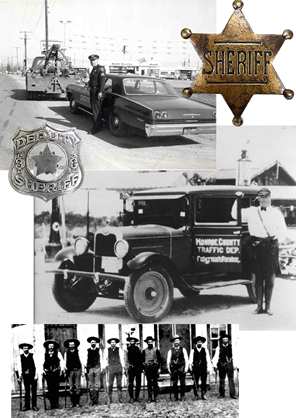Sheriff History

The Office of Sheriff is one of antiquity. It is the oldest Law Enforcement Office known within the common-law system and it has always been accorded great dignity and high trust. For the most part, the Office of Sheriff evolved of necessity. Were it not for laws which require enforcing, there would have been no necessity for the Sheriff. There would have been no need for the development of police administrative, criminology, criminalists, etc. This is not the case however. Man learned quite early that all is not orderly in the universe. All times and all places have generated those who covet the property of their neighbors and who are willing to expropriate this property by any means. As such, man’s quest for equity and order gave birth to the Office of Sheriff, the history of which begins in the Old Testament and continues through the annals of Judeo-Christian tradition. Indeed, there is no honorable law enforcement authority in Anglo-American law so ancient as that of the County Sheriff. And today, as in the past, the County Sheriff is a peace officer intrusted with the maintenance of law and order and the preservation of domestic tranquility.
Sheriff’s have served and protected the English-speaking peoples for a thousand years. The Office of Sheriff and the law enforcement, judicial and correctional functions he performs are more than 1000 years old. The Office of Sheriff dates back at least to the reign of Alfred the Great of England, and some scholars even argue that the Office of Sheriff was first created during the Roman occupation of England.
Around 500 A.D., Germanic tribes from Europe (called the Anglo-Saxons) began an invasion of Celtic England which eventually led over the centuries to the consolidation of Anglo-Saxons England as a unified kingdom under Alfred the Great late in the 9th Century. Alfred divided England into geographic units called “shires”, or counties.
In 1066, William the conqueror defeated the Anglo-Saxons and instituted his own Norman government in England. Both under the Anglo-Saxons and under the Norman’s, the King of England appointed a representative called a “reeve” to act on behalf of the King in each “shire” or county. The “shire-reeve” or King’s representative in each county became the “Sheriff” as the English language changed over the years. The shire-reeve or Sheriff was the chief law enforcement officer of each county in the year 1000 A.D. He still will have the same function in the State of Texas in the year 2003 A.D.
The concepts of “county” and Sheriff” were essentially the same as they have been during the previous 900 years of English legal history. Because of the English heritage of the American colonies, the United States adopted the English law and legal institutions as its owner.
Clearly, the Sheriff is the only viable officer remaining of the ancient offices, and his contemporary responsibility as conservator of the peace has been influenced greatly by modern society. As the crossbow gave way to the primitive flintlock, and the flintlock to the colt.45, the sheriff is not unaccustomed to change. But now, perhaps more than ever before in history, law enforcement is faced with complex, moving, rapid changes in methodology, technology, and social attitudes. As Thomas Jefferson wrote in his “The Value of Constitutions”, The Office of Sheriff is the most important of all the executive office of the county”.
The Office of Sheriff in Texas was created by the Texas Constitution. History indicates in 1827, Stephen F. Austin requested at received authorization for establishment of Constitutional Government in his colony. The first sheriff in Texas was then appointed in 1828. There are 254 counties in Texas and each county has a Sheriff. By statutes, the sheriff is a Texas Peace Officer, a conservator of the peace, enforces the criminal laws of the State of Texas, and is responsible for the county jail, bail bonds, civil process, and security of the courts. In some small counties the Sheriff is also the tax collector. Texas Sheriff’s are elected to office and serve for a four-year term. The sizes of Texas Sheriff’s Offices are as diverse as the population of the counties.
